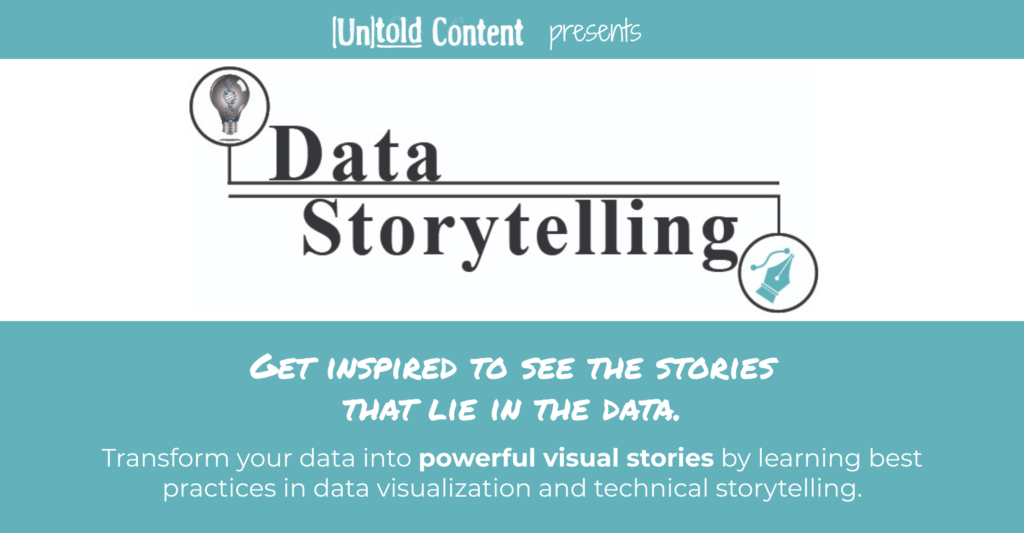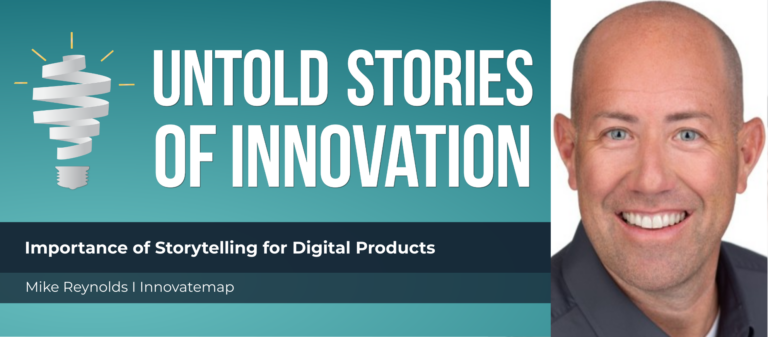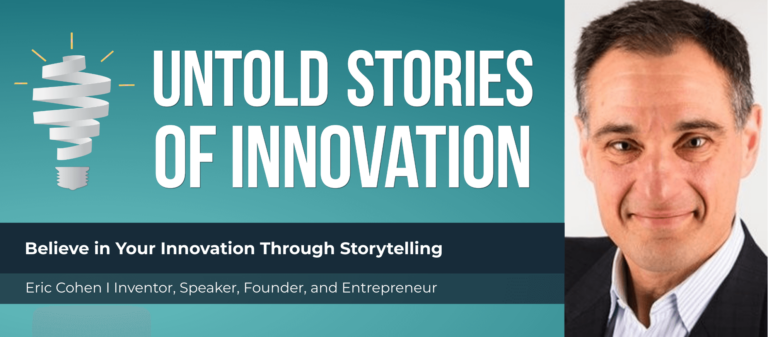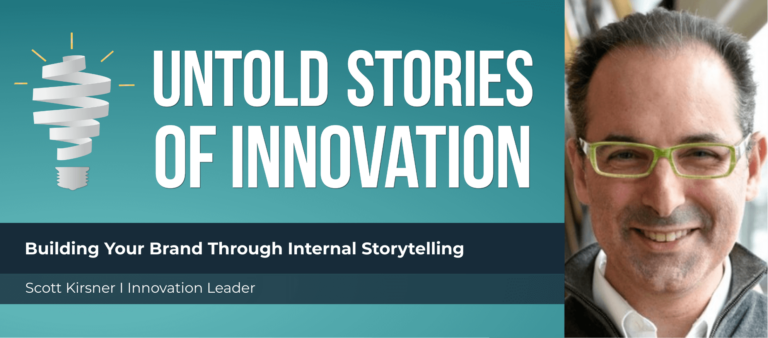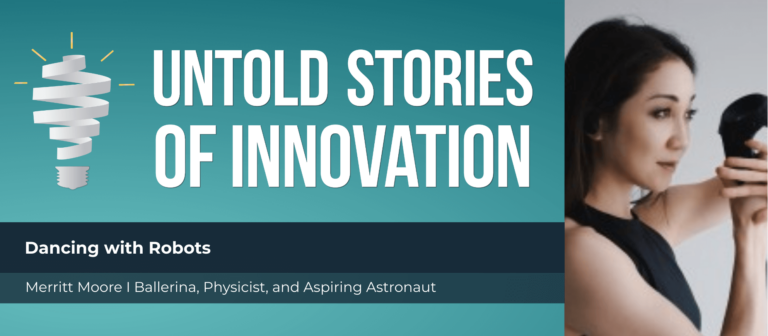Embracing the Unknown with Marguerite Johnson
Embracing The Unknown - Untold Stories of Innovation
“The early storytelling stage should be grounded in the customers' needs. It should reference the analysis you've done, your capabilities as a company and technical expert, and opportunity spaces in your strategy.” - Marguerite Johnson, book author and innovation leader
From today’s episode you’ll learn:
Why do stories matter to the innovation process? What values can be instilled in innovators who share stories? How do innovation leaders inspire creators to tell and share their success and failure stories?
We speak with Marguerite Johnson, published book author of Disruptive Innovation and Digital Transformation: 21st Century New Growth Engines. Marguerite leads transformational growth strategies in innovation, business execution and partnerships. Marguerite has great advice on how innovators must be humble, always looking for advice and feedback from others. Being data-driven, customer focused, and passionate are keys to a successful innovation story.

Marguerite Johnson is the published book author of Disruptive Innovation and Digital Transformation: 21st Century New Growth Engines. Marguerite leads transformational growth strategies in innovation, business execution and partnerships. Her expertise includes: Innovation Strategy, Disruptive Innovation, Digital Transformation, Ideation, Customer Insights, Marketing and Business Plans, Channel and Distribution Marketing, Digital Business Models and Platforms, Open Innovation, Co-Creation, and Innovation Ecosystems.
untoldcontent.com/trainings/data-storytelling-training
TRANSCRIPT – Embracing The Unknown
This episode, Embracing The Unknown is powered by data storytelling training from Untold Content and Data+Science. Transform your data into powerful visual stories by learning best practices in data visualization and technical storytelling. Whether you’re a PowerBI or a Tableau person—or just want to better communicate your data—this workshop will inspire you to see the stories that lie in the data. Learn more at https://untoldcontent.com/datastorytellingtraining/.
Katie: [00:00:00] Welcome to Untold Stories of Innovation, where we amplify untold stories of insight, impact and innovation. Powered by untold content. I’m your host, Katie Taylor.
Katie: Our guest this week is Marguerite Johnson. Marguerite, I’m grateful to have you on the podcast today.
Marguerite: [00:00:09] Hey, thanks for the invitation.
Katie: [00:00:11] Absolutely. Could you share with us where your personal story of innovation began?
Marguerite: [00:00:16] Sure. I actually posted this some time ago on my LinkedIn because it really grounded my passion for innovation. And it started just after undergrad. I had a small apartment in the downtown Detroit area. So like most large, major cities, parking is a premium. You know, it’s sometimes cheaper to live in a developing area like downtown Detroit at that time. So I had a cheap studio apartment. Embracing The Unknown – I would drive to basically a nearby suburb in Detroit to work. But if you missed a certain point in time in the evening coming home, you could very well be locked out of that premium parking. So I ended up parking the evening after coming home from grocery shopping in the back of my building. And, you know, Detroit is one of those older cities where in the back of our buildings are large alleyways lined with dumpsters. And I get out of my car and I’m taking my groceries out of my car and I hear this rustling. And I think to myself, just like a rat or animal, you know, so I start to get a little bit scared and I look up and there is a man and there’s a man digging through the dumpster. So I was afraid and I think he was afraid of me, too, which kind of surprised me because I thought maybe more that I would be afraid of him than him of me. But I learned later that some people take advantage of homeless people.
Katie: [00:01:52] Mmhmm.
Marguerite: [00:01:52] But I didn’t know that at the time.
Katie: [00:01:53] Sure.
Marguerite: [00:01:54] And. So he recognizes me and keeps going through the dumpster and I decide I’m going to get into my apartment and I’m going to bring him something. So I grab two cans of soup. I ran back down the alleyway. By this time, he’d already moved a couple of dumpsters down and there’s not very much light in the back of these buildings. And so I, I kind of shouted to him and extended my arms, you cannot shoot in each hand. And I said, here, here you can have these. And he comes back into the light in the alleyway and tries to look at what’s in my hand, walks closer and he shakes his head. He says, I don’t have a can opener.
Katie: [00:02:39] Wow.
Marguerite: [00:02:39] And that broke my heart.
Katie: [00:02:40] Yeah.
Marguerite: [00:02:42] Because here I thought I was solving a problem. I thought I was in some way contributing to his life. And from that day on, I vowed to never make assumptions, to always seek to understand and not to try to solve problems without context, without reference. And so innovation is very, very personal for me.
Katie: [00:03:09] Gosh, I am so grateful that you shared that experience and kind of opened up and were vulnerable enough to kind of keep that at the center of why you innovate. In our research over the last couple of years, around innovation storytelling, one of the key drivers that we identified as a research team is empathy. And it’s talked about a lot inside of the innovation process in terms of how to really understand who you are innovating for and how you’re going to change their lives. And that example just really strikes me as a powerful one in terms of empathizing. And to be empathetic means to really understand someone in their context.
Marguerite: [00:03:52] Embracing The Unknown – Yeah, it’s been…. You know, I had no idea that my career would lead me down that path. I mean, here I was in my 20s just you know, kind of finding my way. It stayed with me. And it sticks with me to today.
Katie: [00:04:07] Do you think that that experience made you hyper curious from that point on, maybe even more so than you had been? It seems like that was such a turning point in how you looked at the world and how you thought about the experiences of others. Do you think that it sort of instilled a new and deeper level of curiosity and empathy toward others?
Marguerite: [00:04:31] Yeah, I hold the…. [unclear wording] very precious, right? So, you know, innovation… It has to be more. It has to mean more. And not that, you know, every innovation has to have a social story connected to it. You know, many times, particularly in my line of business, we’re innovating because we’re solving for a job to be done and a job to be done with technical assets and capabilities and expertise within a defined space. And so it’s not always possible to apply that expertise to solve every issue. But it does make me humble. It also makes me seek to understand. It takes me out of my own personal point of reference. It helps me to put myself in someone else’s shoes and to recognize my own biases. So I would say it has more meaning than I originally assigned to it when it was happening to me. Absolutely.
Katie: [00:05:48] I want to dig into this idea of storytelling and the role that it plays in innovation, because I think you just spoke to it. Not just understanding, you know, I think even in highly technical areas of innovation where you’re an engineer, for instance, or a designer or a product team or a marketing team working with a very specific kind of technical or creative brief and trying to innovate against it. But I think every technical brief and every creative brief, if it’s not infused with a deep understanding of how it’s going to impact the user, then it’s sort of failing to some degree. So could you kind of explain your thoughts on that? Tell me a little bit more about the role that you feel that storytelling can play in innovation.
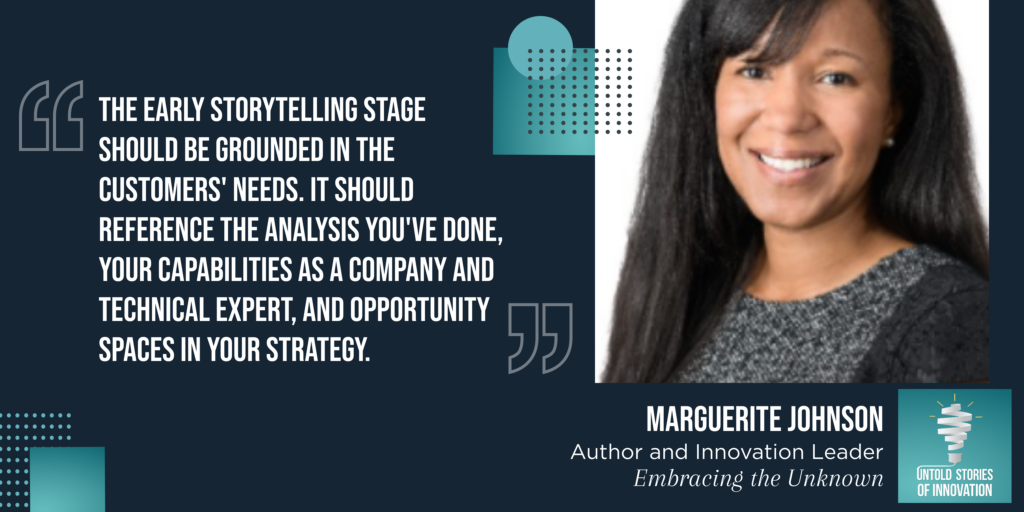
Marguerite: [00:06:41] Storytelling in the beginning, and I caution storytelling in the early stages from being too imaginative, right? In the early stage of storytelling, should literally be grounded in the customer’s needs. As what you’ve heard from your customer from speaking across the value chain, from your suppliers to your partners, to your internal customers. And learning and understanding what that need is and in various forms, what that need is. And so not necessarily being fanciful. You are very much grounding that understanding in the precise needs spoken by your customer and spoken by those stakeholders in the value chain. So it’s important to keep that in focus and keep that in mind and not go too far into making up a story. It should really reference, you know, the analysis that you’ve done, your capabilities as a company, as a technical expert, your opportunity spaces in your strategy. So in the early stages, it’s very important to use actual data and actual research to ground the storytelling and not let the storytelling be for fanciful sake.
Katie: [00:07:58] Do you think that data can tell a story?
Marguerite: [00:08:02] Oh, my gosh. Absolutely. Absolutely. In fact, the data in the early stages of your work should be the story. I often say if you can’t figure out how to explain your customer, use the verbatims from your customer interviews. It’s much more…. It’s a stronger context and a reference point for other people. When you are pitching a new innovation, a new concept, a proposal to say X, Y, Z customer said this and read the verbatims from those conversations. And that has credibility. It has reference and has accountability. I mean, your customer tells the best story, I would say.
Katie: [00:08:50] And so it sounds like your advice around not letting story have too much of a prominent role in the beginning is not so much the ability of evidence or data to ground your… To sort of be the story itself. But the idea of sort of making really big claims or doing you know, I think some of us as children, certain communities or cultures will say, you know, to our children when they’re telling lies. “Oh, you’re telling stories,” right? Like that sort of thing.
Marguerite: [00:09:21] Exactly.
Katie: [00:09:21] Yeah. But I think if we kind of reframe that a little bit and I think with the advice that I hear from you and I think it’s so brilliant, be cautious of dramatizing the impact or the use, the usability or the function, too early on in the process, be…. Use the data and and the voice of the customer and different, you know, analysis that you’re conducting in your research to really, especially in the beginning, ensure that that is the heart and soul of the story.
Marguerite: [00:09:58] Exactly. Exactly. Because that is what’s going to take you through all of those changes that are possible. The other thing, Katie, is, you know, when you’re dealing with early stage innovations, you often do not have data that’s solid, right? You are very much on a journey. And innovation in the early stages is a very non-linear process. And you cannot draw… you know, step one leads to step two types of conclusions. And if you are too imaginative in the early stages and your story doesn’t have evidence based around it, when the market dynamics and when the conditions change, you often don’t have good justification to explain why your story doesn’t fit anymore. But if your early stage discussions around storytelling are grounded in those facts, when those facts become more known, or when that information shifts and changes because the market shifts or changes, you have good justification for the reason why your story’s changed.
Katie: [00:11:04] That is such an important point. Can you speak a little bit about getting internal buy in and in the role that you know that communication plays and being able to generate that?
Marguerite: [00:11:19] Oh, I have actually a couple examples, if you would indulge me.
Katie: [00:11:23] Please.
Marguerite: [00:11:24] I, you know, oftentimes innovation happens within the R&D group and the very tight knit organization, and we spend a lot of time seeding and vibing off of one another. But if you do not have the buy in from your larger organization, you can not be successful converting your innovative proposals, products, services, that is, business models, into profitable growth. And that’s ultimately what innovation should be. I mean, that is your best justification for the resources that are put forth in the investment in R & D when some of that stuff comes to that pipeline and it’s converted into profitable growth. But if you do not bring your broader organization in on those innovative ideas, then, you know, you could possibly run into some walls. And so in my past, one of the ways that I brought the broader organization in on innovation is through the game of bingo. And I know it’s a kid’s game and we’ve all played this game. And it seems very simple. And it was surprising how, you know, everyone kind of got on board. I’ll explain with the B I N G O stands for. So the “B” is for business. The “I” is innovation and the “N” is numbers, “G” is goals, basically those goals are on your strategy, and “O” is for operations and organization. So what we did was we printed these bingo cards and we allowed various people to submit ways that the, you know, the numbers or the business impacted a particular innovation that we were highlighting and we will pull from this list of submissions. And, you know, if it aligned with the card that you had that was printed and passed out throughout the organization, you know, you’d call “bingo.” You know, at the end of the week, you could say, you know, this idea aligned with my business, my card, and, you know, this number aligned with, you know, my card. And the organization would, you know, kind of give cheers and you would show up on the screen and the plan or you would show up in a newsletter for the employees. And so there was no like necessary prizes given out, but it was more like bragging rights that you were able to identify how those feedback or that input throughout the organization fit into your card and show. Yeah, it was a simple thing that actually worked out really well. It was a surprise.
Katie: [00:14:06] Game-ifying the innovation process, I think is so smart! Yeah. I think I’ve heard quite a few innovation leaders like yourself on this podcast share how they are using games or game-ified thinking to spark creativity and build empowerment across the enterprise. And I love that example and it really falls in line with that kind of strategy.
Marguerite: [00:14:30] Yeah, the other one is biomimicry. And you’ve probably heard a lot about this one, too. It’s been around for a long time, but it’s grown in application. You know, a couple years back, we were faced with a building code change and the company that I work for, not Leggett and Platt at that time, was very, very heavy in the insulation market. And I would say they were one of the market leaders in insulation. And with the change in the building codes requiring continuous insulation, there was a threat that we could possibly lose there if we did not have a response to this continuous insulation, new building code. And with a team of scientists and process engineers, I knew I had to get them in a different headspace because they knew everything about insulation. Right? And I thought, OK, well, how can I get them to understand the problems that were occurring and what possibly could be a solution to some of these problems without them basically regurgitating their expertise in this space. And so I thought, let’s use biomimicry, let’s follow up with nature, some of these concepts of how things are insulated. And so we met in this room and all kinds of ideas came running, which also was a surprise for me because I thought there would be so reluctant and hesitant and…
Katie: [00:15:56] Right. I thought, that’s what you were going to say.
Marguerite: [00:15:59] Yes. Dig their feet in and say what childish thing? Biomimicry? But they came up with all kinds of things from how tree sap collects in the tree bark. And you know how that composite was a really good way for things to be sealed. They talked about honey. They talked about mud, molasses and finally we settled on the composite of spider web and spider saliva. And I remember thinking about how well spider webs attached to exterior trends and how we could probably watch a spider web blow in the wall in a torrential downpour and it would stay fixed.
Katie: [00:16:47] Yeah.
Marguerite: [00:16:48] So it met and met the requirements of lightweight, high-adhesion, and a composite. And we actually based our [unclear wording] patent on this concept that was developed out of biomimicry.
Katie: [00:17:02] Beautiful. That’s incredible. I’m reminded, as you say that, first of all how critically important it is to lean into creativity and think outside of the way we’ve always thought about things. And that is so challenging for experts to do.
Marguerite: [00:17:20] Hmm. Yeah.
Katie: [00:17:21] Some of the content strategy work that we do with our clients at Untold, and as you know, we focus on scientific, medical and technical and social innovative companies and we help them in communicating and getting more buy-in for their best ideas and sort of establishing their thought leadership. And one of the exercises we do in every content strategy session and it never fails, is to do a rapid metaphor creation exercise to say if your organization or your innovation team were a metaphor from nature, a metaphor from animals, a metaphor from action, what, you know, using different categories, what would you be most similar to? And letting people ideate around that? And it depends on the groups, you know. Sometimes people lean into it and are willing to kind of be creative. Sometimes it’s a little more challenging for them to see how this is going to matter. But helping people think in those sort of creative ways, it just positions us to think differently and come up with new ways of conceptualizing what we do and why it matters and why we’re different.
Marguerite: [00:18:33] Yeah and I think that, you know, sometimes scientists and engineers and technical people are given a bad rap when it comes to creativity, right? You know, people don’t think of us as playing with things, right? Or experimenting, but that is something that stays with you, right? So tapping into that and building on that childlike curiosity is something that a lot of people welcome. And could could, you know, maybe something that maybe was unexpected. But, you know, if you try it out, you’ll be surprised. And I think that’s what you’re saying. People are leaning into it, as you say. And they’re accepting this and they’re taking on this challenge and they’re welcoming it.
Katie: [00:19:26] You know, I’ve never thought, as we present that exercise to scientists or engineers, I’ve never thought to lean into the fact that they are constantly returning to the lab bench and asking why or returning to, you know, their computer or to each other and asking why, digging deeper. You know, scientists always have the heart of an explorer. And then the examiner in question or an analyst. So really, I guess our team could be sort of drawing that comparison with those teams and help paint that metaphor for the exercise. And I think that there would be more comfort with it, actually, to sort of say you already are creative, you already are a discoverer, and question- asker. So let’s lean in here.
Marguerite: [00:20:12] Mmhm. Yeah.
Katie: [00:20:12] But I want to dwell, I want to kind of lean in again to this idea of evidence. And one of the struggles that, you know, it’s a kind of common struggle among engineers or data scientists or lab bench scientists to believe in the data and to gather and gather and gather evidence. And sometimes it can be a challenge when they’re tasked with getting buy-in for a larger, you know, action or concept that should be presented in light of that data. And in light of those insights, it can be challenging to know how much evidence is too much for me to share with stakeholders? How much is too little? What are your thoughts on how to create kind of the right balance between evidence and impact?
Marguerite: [00:20:58] You know, I… When I was much younger, I had quite a lot of doubt about presenting information that wasn’t complete, right? You worry that, you know, if you get it wrong and how that could impact your career and how people looked at you. But I actually was able to prove myself wrong in that way. And this example that I’m going to give you speaks to how I bring people into my thought process and have them share with me in my levels of uncertainty.
Marguerite: [00:21:37] So I typically ask three categories of questions. When I have a project or I have a task before me that I’m not 100 percent well, never 100 percent, to be honest, where I’m kind of left, I’m kind of left more uncertain than usual, I’ll say that.
Katie: [00:21:56] OK.
Marguerite: [00:21:57] I often ask, what do we know as a project team, as a company about this thing? And I want to know, do I have any validated data existing? Do I have a customer who’s vouched for this? Do I have market data or industry reports or internal knowledge that tells me that we know for certain, you know, this thing about this, this project, this task. And then I want to know what I don’t know, but what is knowable only if I ask. And that’s ask a customer or supplier, another expert or seek out, you know, some content like purchasing a report. And then the last one is, what do I not know and what can’t I know? Because it’s just not in my vantage, It’s just not in my level of access. Often when we supply to a supplier who supplies to a customer, you are left at this, you know, level three of understanding. I would say this level three, a category of understanding. There are things that you don’t know, but you also don’t have access to.
Katie: [00:23:09] Sure.
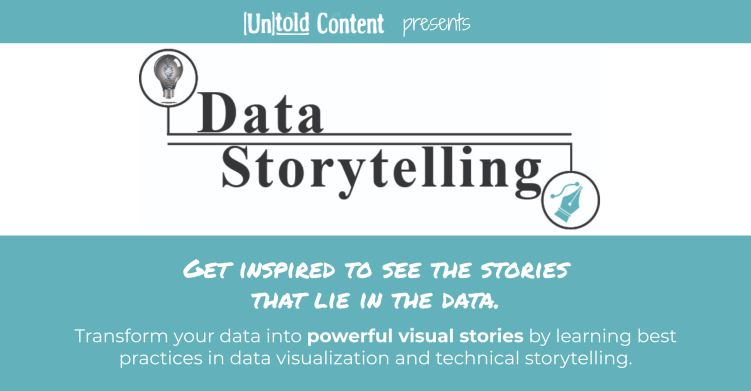
Marguerite: [00:23:09] And that lack of knowledge, it can sometimes paralyze people and they’ll start to try to interpret it or figure out, you know, how to plug those holes in those gaps in knowledge. And that’s not necessarily the way to go. I find if I share with my team and I say to the broader organization: this is what we know. This is what we don’t know, but we can find out. But these are the things that we don’t know. And from our vantage at this point in time, we can’t know. And when we document all those assumptions that we’re making. And we share those with our stakeholders and decision makers and have them go on this journey of finding out the answers. And not necessarily coming with some prepackaged, you know, basically…. Fiction. And I find that it’s always more helpful to expose the gaps in your knowledge than to try to falsely fill them in. That’s a trap, I think.
Katie: [00:24:11] Yes, absolutely. I think of the humility that that takes. And the credibility that it can build at the same time. It’s humbling to say, here’s what I don’t know, but could be known. Here’s what I –here’s what we don’t know and we’re not sure it can be known. And making that very transparent seems to be one of the strongest ways to build credibility.
Marguerite: [00:24:35] Yeah. Yeah, absolutely.
Katie: [00:24:38] Because, you know, opposed to… I guess the opposite would be coming in with a finalized deck saying, I am sure that this will work for all of these reasons. And it’s kind of interesting. I’m comparing now, I know you work in enterprise innovation, but I’m comparing some of the typical storytelling techniques that are expected within the startup world. And I would say that most pitches are expected to not necessarily go into the vulnerabilities of the idea. The most pitches focus primarily on: here are all of my reasons to believe that this is great and it’s going to work. It’s kind of interesting to think about – and again, I think I’m drawing a comparison there for startup pitches that are very public – I bet that those pitches that are happening as a company is forming or sort of behind closed doors when talking to potential investors, those conversations are likely more vulnerable and much more open about addressing risk and unknowns. But it strikes me, as I would think I’d like to see more public-facing startup pitches or innovation pitches, use humility and invite stakeholders or the audience in to sort of build a shared understanding of what’s not known.
Marguerite: [00:26:08] That’s, yes, startups and [unclear wording] of course, and in tech scouting and a lot of pitch competition events. I attend a number of them because of my role. And, you know, oftentimes you could… You can see where maybe they glossed over some information because maybe they did not have all of the details that they needed. And I don’t know if, you know, it’s kind of the nature of the beast that, you know, everyone wants an answer, even if it’s not the right answer. But I do oftentimes see that, you know, there’s this peer pressure to give an answer, you know, either, you know, from a startup who’s pitching in a public space. And some of these is a competition venture. Even one-on-one matches with startups. They feel like there’s some pressure to give an answer when I’m very, very comfortable with saying, you know, this is what I know and this is what I don’t know and this is what I can find out. I’ll add a little bit onto that, Katie. And this is something that you’ll probably find internally within large organizations. Large organizations have to do quite a lot of financial forecasting and planning against their projects. And when your company requires you to pull together, you know, [unclear wording], and, you know, NPVs and all of these financial metrics on your project well ahead of when you would even have that information. And people feel like they have to pull something together for a slide and not having that level of detail, they, you know, will be basically under pressure to put something in those boxes. And, you know, I’m much more comfortable saying, you know, this is what my estimate is and these are the assumptions that I made behind that estimation. But I refused to put a hockey stick in front of you and tell you that, you know, we’re going to have, you know, exponential accelerated growth because I’ve put these imaginative numbers in these boxes and I don’t really have any validated evidence to justify that that’s the case.
Katie: [00:28:24] That’s a great point. You know, digging in to that moment where as an innovation leader at an enterprise level, you’re opening the doors to startups and you’re hearing their pitches. What would you like to see more of when it comes to how they communicate with you about the potentials and what sort of builds credibility in your mind the best in that storytelling moment?
Marguerite: [00:28:50] I really would like start ups first to understand where they fit into a larger ecosystem, that would be first and foremost. But first and foremost in how their business model will eventually make money. Right? So we understand that, you know, not everyone is profitable out the gate. But I would like to see some evidence that there’s some thought towards an exit strategy and how that business model will develop over time and how you’re tracking that business model. And I say ecosystem [because] no business, you know, exists in a vacuum. I mean, even if you’re a small startup all the way to a large organizations like Procter and Gamble. Right? Everyone has to fit into an ecosystem. And if you have an expectation that your product will require an upending of an ecosystem in order for it to work, then that’s a serious challenge. That means you are not scanning the environment. That means you have not thought very clearly about what alternatives or substitutions are out there. And you’re thinking you were just going to take on the world and change it all with your product. And I think that’s, you know, that’s a great passion, right? To hear the startups tell you how they’re going to take on the world. But, you know, we all have to be realistic with the changes that we can make and have some understanding of where your business model will go and where you are currently in making that business model profitable. I think those would be the two biggest things that I find that people a little bit more…. They could live without the fiction in the story.
Katie: [00:30:39] Sure. Yeah, absolutely. I think it’s… That parallels the advice you were giving at the internal moment, rather than just putting projections up that are best-case scenario projections or, you know, sort of using data to tell only the story you want it to tell. Right? That is the vision that you shared of logging in those numbers. Ultimately, that makes it a much more devastating and challenging conversation when the milestones don’t match that original projection. Is that sort of what you were alluding to when you said, let’s be realistic from the start as best we can?
Marguerite: [00:31:20] Yes, let’s be realistic from the start. Tell me where you are and how you’re going to get to your goal.
Katie: [00:31:25] Yes. What other pieces of advice do you have for innovators, whether… You shared really great pieces of advice for startup innovators looking to partner with Big Co’s and with industry. What advice would you give to innovators inside of industry? You know, inside of Big Co’s, if you will, as they prepare to convey their great ideas, get internal buy-In and ultimately get buy-in from users and customers.
Marguerite: [00:31:51] So I, you know, this goes back to the story of the gentleman in the alleyway outside of my building. And I wasn’t mature enough in my thinking at that time to check myself and to check my bias and to understand what I was bringing to his story that was possibly impeding really seeing him or seeing the situation. So I would say seek alternatives and perspectives. And having all of the answers should indicate that you have a bit of tunnel vision. You know, it’s always helpful at the start to identify your blind spots. And that’s where I go back to those three questions: what do you know? What do you not know, but you can know? And what do you not know, and you can’t know? Because checking your bias and identifying your blind spot is truly the point of maturity when you’re really seeing things with your eyes completely open. And absolutely don’t see or get your customer. I mean, that’s in fact the reason why you’re innovating. They should be the reason for the story.
Katie: [00:33:06] I love that.
Marguerite: [00:33:06] Highlight your journey. We had brilliant failures. Right? There’s so many brilliant failures that are public from large companies. I often hear the Thomas Edison one repeated and the WD 40, you know, brilliant failure. But there are so many brilliant failures that are public and they’re probably a lot of them are internal to organizations. Now, that’s a good story, right? There was some learning that happened from there. So don’t forget that journey even if it results in a brilliant failure.
Katie: [00:33:42] We conducted research at Untold Content where we looked at thousands of different types of innovation stories and came up with patterns that we saw, and one of the patterns was what we called the “perspiring innovator,” which is not giving up. Right? Returning to the bench. So, WD 40 is one of the examples. For folks that don’t know, they all, you know, that organization, they knew the problem that they were trying to solve, but they could not figure out the right solution. And it took thirty-nine different formulations before they finally came up with number 40. And then they named it, they branded WD-40 with that label to sort of reveal the importance of perspiration to the art of innovation.
Marguerite: [00:34:27] That’s the best trophy, isn’t it?
Katie: [00:34:28] Yeah
Marguerite: [00:34:29] I mean, this is… Definitely your sweat equity went into the 40th attempt and now you have success. That’s awesome.
Katie: [00:34:38] And I love that, you know, that you linked that to the importance of sharing failure stories too – failure narratives – and being comfortable doing that and doing it in a way that always gets to, not necessarily, you know, the downtrodden. The idea is to get comfortable sharing the learning that came from that and that if you went through the process or the innovation stage-gate and the way that you know, you know, if you followed those steps that you believe in, you looked at the data and a clear line of sight, just because the idea had a red light or got shelved, that doesn’t mean that it necessarily failed. If you learn from it rapidly and you apply it to the next opportunity.
Marguerite: [00:35:24] Absolutely. Absolutely. And, you know, I’ve also spent quite a lot of time going back over some of the ideas that didn’t make the cut in the early stages. And now with the use of open innovation, which is something that was always there, right? Open innovation is just a fancy way of saying going out to industry and finding a partner.
Katie: [00:35:47] Mm hmm.
Marguerite: [00:35:48] And, you know, some of these ideas were shelved or were basically held back or put in park status because we didn’t have the knowledge internally to move them forward. But now with this, you know, a lot of open innovation platforms, you can put those ideas back out there and play again because the knowledge, you know, may exist somewhere. And so you may have had a brilliant failure in the past. That brilliant failure may just have the perfect misfit match out in an external partner.
Katie: [00:36:19] That’s a really great point. Yeah, and any other pieces of advice you would share as we wrap up our conversation?
Marguerite: [00:36:28] Ah, my last one is to be humble, and I have to tell myself this, too. I’ve had a lot of successes in my career and I can get a little ahead of myself. I’m just being honest here. And I just allow everyone around me to restrain me. Right? And to ask me to tell them why and not just trust that I say it. And so I invite people to ask me questions and to challenge my knowledge. And sometimes the things that people tell me don’t necessarily fit into the scenario or fit into the project or the context that I’m dealing with. But it may apply in some general way going forward. And so I like to just, you know, be in a position that people feel like they can come to you and tell you how they feel about your project, how they feel about your pitch, how they feel about the overall approach and having those constant checks on you. It keeps you humble. It keeps you from feeling like, you know, you don’t need any input from anyone else. And again, I’m going to take on the world all by myself. And so remaining humble, remaining engaged, acknowledging that you don’t have all the answers in that is absolutely okay. And you can use a larger organization to, you know, keep you honest and keep you on the right path.
Katie: [00:37:54] That’s incredible advice. And I think throughout our conversation, you’ve placed so many really practical tactical ways that we can remember to be empathetic, humble, open to feedback and ready to pivot or change or build upon the ideas of others. So I am so incredibly grateful. I don’t… I think we could talk all afternoon about these topics, but I know our time has been limited. Thank you so much for being on the podcast. I know the innovation community will get so much out of this conversation.
Marguerite: [00:38:26] Thank you, Katie. And I appreciate the time.
You can listen to more episodes of Untold Stories of Innovation Podcast.
*Interviews are not endorsements of individuals or businesses.
